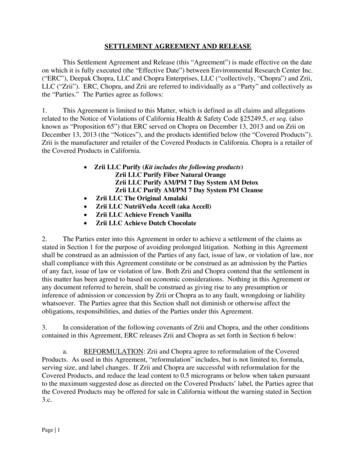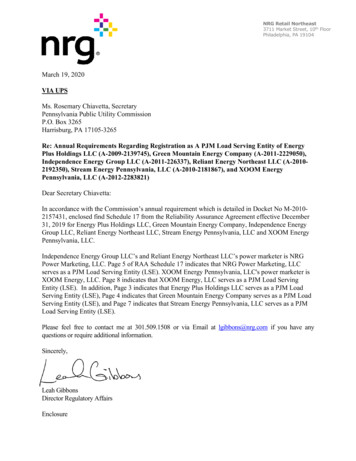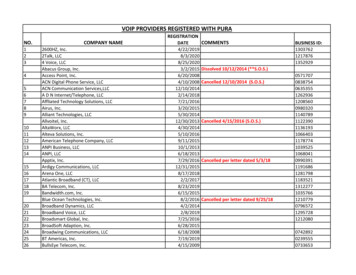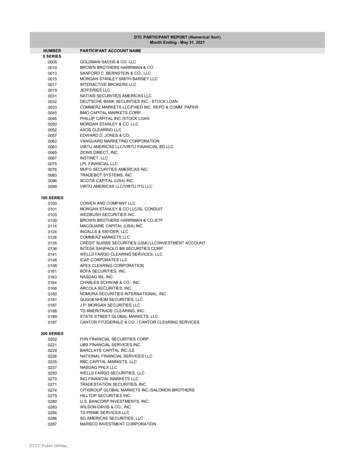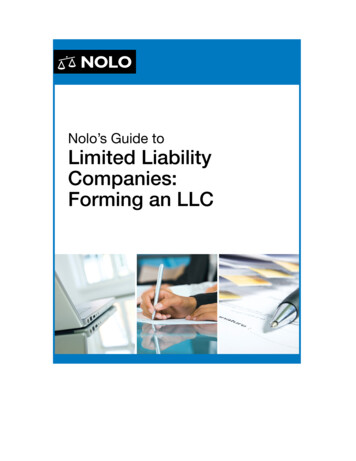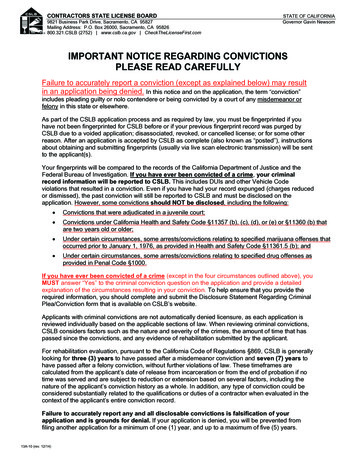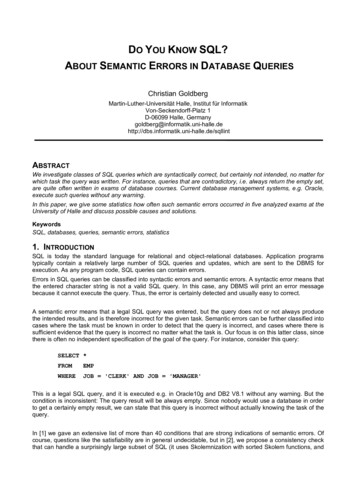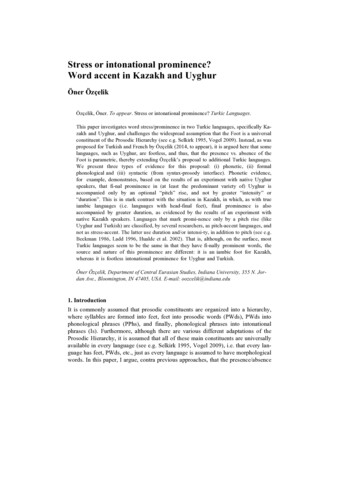
Transcription
NLP PractitionerCertification CourseTraining Manual
NLP Results Academy – Practitioner ManualTraining ManualNLP PractitionerCertification CourseBy Adam Heller 2014Coach Heller LLCPO Box 4948Laguna Beach, CA949-497-8383http://NLPResultsAcademy.comThis Manual Belongs To:Copyright 2014 – Coach Heller LLC1
NLP Results Academy – Practitioner ManualWelcome to Your Training!Greetings and welcome to your NLP Results Academy NLP Training. NLP is a largebody of knowledge primarily concerned with how to achieve excellence. You can read acomplete definition and description of NLP a few pages further on in this manual. Tomake the training process more effective, we will be teaching NLP to you in digestible‘chunks.’In the Practitioner Module of this training course, we will focus on providing you withthe information and interventions that make up the foundations of NLP. In the MasterPractitioner section, we will present you with advanced concepts and interventions thenfinally bring all the pieces together in a way that will prepare you to help individualclients make behavioral changes to achieve excellence in their lives.Training Chunks and FlowPractitioner ModuleInformationInterventionsMaster Practitioner ModuleAdvancedInterventionsBringing it allTogetherCopyright 2014 – Coach Heller LLC2
NLP Results Academy – Practitioner ManualTable of ContentsWelcome to Your Training!.2Table of Contents .3Introduction to NLP .6Short Definition of NLP.7What is NLP? .8Questions & Answers about NLP .12NLP Communication Model.14Internal Representations.15Cause & Effect .16Perception is Projection .17Responsibility for Value .18How to Get Certified.19State vs. Outcome .20Keys to an Achievable Outcome.21Well Formedness Conditions.22Presuppositions of NLP .23Functions of the Unconscious Mind .24Sensory Acuity.25Rapport.26Representational Systems .27Predicates .29List of Predicate Phrases .32Intonation Patterns .33Eye Accessing Movements .34Eye Pattern Descriptions and Questions.37Mirror Neurons .38Copyright 2014 – Coach Heller LLC3
NLP Results Academy – Practitioner ManualTable of ContentsWeek 2NLP Interventions .40Sub-Modalities .41Sub-Modality Techniques:.42Sub-Modalities Evaluation.43Worksheet .43Sub-Modalities Evaluation.44Examples of Triggers in NLP Contexts .45Sub-Modalities Like to Dislike.46Sub-Modalities Belief Change.47Swish Pattern.48Swish Pattern.49Perceptual Positions .50Language .51Chunking .52Lateral Chunking.53Metaphor .54Milton Model .55The Meta Model.57The Meta Model Chart.58The Fast Phobia Model .59Copyright 2014 – Coach Heller LLC4
NLP Results Academy – Practitioner ManualTable of ContentsWeek 3Reframing.61Anchoring.63Anchoring.64Stacking Anchors .65Collapse Anchors .66Chaining Anchors .67Chaining Anchors .68The Ring of Power .69Intro to Strategies .70Strategies .71T.O.T.E. Model of Strategies.72Strategy – Well Formedness .73Strategies – TOTE.74Strategy Elicitation.75Strategy Elicitation Steps .76Representational Systems .77Installing Strategies.78Motivation Strategies .79Strategy Problems .80Strategy Examples.81Strategy Elicitation.82Practitioner Certification Completion.83Copyright 2014 – Coach Heller LLC5
NLP Results Academy – Practitioner ManualIntroduction to NLP(Neurolinguistic Programming)Welcome to the world of NLP. Neurolinguistic Programming is the systematic study ofhuman performance. NLP is a practical application of how people think. This study ofthe structure of the subjective experience can be broken down into their smallestcomponents (or chunks) and changed, modified, improved upon, or removed. Thisallows a framework for growth and change at much deeper levels more quickly than wasoriginally thought.NLP was developed through the efforts of several people. Some of the more notablenames are Leslie Cameron-Bandler, Steve and Connirae Andreas, Robert Dilts, RichardBandler, John Grinder, and many others. Their studies began in the 1970’s and havecontinued to grow to the present. NLP techniques enable therapists to be much moreeffective in assisting change in their clients lives. Neurolinguistic Programming broughtabout the ability to analyze and transfer human excellence, thus resulting in the mosteffective and practical psychology known.NLP is based on the work of several people whom the above-mentioned studied. Theyinclude Alfred Korzybski, Virginia Satir, Milton Erickson, Fritz Pearls and GregoryBateson, among others. They were chosen as excellence to model.This is a hands-on learning experience. Keep an open mind and be willing to allow thetraining to work with you at all levels.(Please note that this manual is meant as a companion, supplement, and reference to thecourse, not an exact duplication of the videos/DVDs. Some exercises may not appear inthe exact order the class is taught. Please reference the table of contents for pagenumbers.)Copyright 2014 – Coach Heller LLC6
NLP Results Academy – Practitioner ManualShort Definition of NLPNeuro:The nervous system (the mind), through which weinteract with the external world to receive and processexperiences through the five senses: Linguistic:Language and other nonverbal communication systemsthrough which our neural representations are coded,ordered and given meaning. Includes: atoryPicturesSoundsFeelingsTastesSmellsWords (Self Talk)The process of how we run our internal programs toachieve specific outcomes.Copyright 2014 – Coach Heller LLC7
NLP Results Academy – Practitioner ManualWhat is NLP?A Model of Communication and PersonalityNeuro Linguistic Programming (NLP) began as a model of how we communicate toourselves and others. It was originally developed by Richard Bandler, John Grinder andothers. This model explains how we process the information that comes into us from theoutside. The belief is that “The map is not the territory.” And so the internalrepresentations that we make about an outside event are not necessarily the event itself.Typically, what happens is that there is an external event and we run that event throughour internal processing. We make an Internal Representation (I/R) of that event. That I/Rof the event combines with a physiology and creates a state. “State” refers to the internalemotional state of the individual – a happy state, a sad state, a motivated state, and so on.Our I/R includes our internal pictures, sounds and dialogue, and our feelings (forexample, whether we feel motivated, challenged, pleased, excited, and so on). A givenstate is the result of the combination of an internal representation and a physiology. Sowhat happens is that an event comes in through our sensory input channels which are: VisualIncluding the sights we see or the way someone looks at us; AuditoryIncluding sounds, the words we hear and the way that people say those words to us(unless you specifically want variety in form); KinestheticOr external feelings which include the touch of someone or something, thepressure, and texture; OlfactoryWhich is smell; and GustatoryWhich is taste.The external event comes in through out sensory input channels and it is filtered and weprocess the event. As we process the event, we delete, distort, and generalize theinformation that comes in, according to any number of several elements that filter ourperception.Deletion:Copyright 2014 – Coach Heller LLC8
NLP Results Academy – Practitioner ManualDeletion occurs when we selectively pay attention to certain aspects of our experienceand not others. We then overlook or omit others. Without deletion, we would be facedwith much too much information to handle with our conscious mind.Distortion:Distortion occurs when we make shifts in our experience of sensory data by makingmisrepresentations of reality. In Eastern philosophy there is a well-known story ofdistortion in the rope versus snake analogy. A man walking along the road sees what hebelieves to be a snake and yells “SNAKE.” However, upon arriving at that place he isrelieved as he discovers that what he sees is really only a piece of rope.Distortion also helps us in the process of motivating ourselves. The process of motivationoccurs when we actually distort the material that has come into us that has been changedby one of our filtering systems.Generalization:The third process is generalization, where we draw global conclusions based on one ortwo experiences. At its best, generalization is one of the ways that we learn, by taking theinformation we have and drawing broad conclusions about the meaning of the effect ofthose conclusions.Normally, the conscious mind can only handle 7 (plus or minus 2) items of information atany given time. Of course, many people can’t even handle this number, and I knowpeople who are a “1 (Plus or minus 2).” How about you? Try this: Can you name morethan 7 products in a given product category, say cigarettes? Most people will be able toname 2, maybe 3 products in a category of low interest and usually no more than 9 in acategory of high interest. There is a reason for this. If we didn’t actively deleteinformation all the time, we’d end up with much too much information coming in. In fact,you may have even heard that psychologists say that if we were simultaneously aware ofall of the sensory information that was coming in, we’d go crazy. That’s why we filter theinformation.So, the question is, when two people have the same stimulus, why don’t they have thesame response? The answer is, because we delete, distort, and generalize the informationfrom the outside.We delete, distort and generalize the information that comes in from our senses based onone of five filters. The filters are, Meta Programs, belief systems, values, decisions, andmemories.Meta-Programs:Copyright 2014 – Coach Heller LLC9
NLP Results Academy – Practitioner ManualThe first of these filters is Meta Programs. Knowing someone’s Meta Programs canactually help you clearly and closely predict people’s states, and therefore predict theiractions. One important point about Meta Programs: they are not good or bad, they are justthe way someone handles information.Values:The next filter is values. They are essentially an evaluation filter. They are how wedecide whether our actions are good or bad, or right or wrong. And they are how wedecide about how we feel about our actions. Values are arranged in a hierarchy with themost important one typically being at the top and lesser ones below that. We all havedifferent models of world (an internal model about the world), and our values are theresult of our model of the world. When we communicate with ourselves or someone else,if our model of the world conflicts with our values or their values, then there’s going tobe a conflict. Richard Bandler says, “Values are those things we don’t live up to.”Values are what people typically move toward or away from (see Meta Programs). Theyare our attractions or repulsion’s in life. They are essentially a deep, unconscious beliefsystem about what’s important and what’s good or bad to us. Values change with contexttoo. That is, you probably have certain values about what you want in a relationship andwhat you want in business. Your values about what you want in one and in the other maybe quite different. And actually, if they’re not, it’s possible that you may have troublewith both. Since values are context related, they may also be state related, althoughvalues are definitely less related to state than are beliefs.Beliefs:The next filter is beliefs. Beliefs are generalizations about how the world is. One of theimportant elements in modeling is to find a person’s beliefs about the particular behaviorwe are trying to model. Richard Bandler says “Beliefs are those things we can’t getaround.” Beliefs are the presuppositions that we have about the way the world is thateither create or deny personal power to us. So, beliefs are essentially our on/off switch forour ability to do anything in the world. In the process of working with someone’s beliefs,it’s important to elicit or find out what beliefs they have that cause them to do what theydo. We also want to find out the disenabling beliefs, the ones that do not allow them to dowhat they want to do.Copyright 2014 – Coach Heller LLC10
NLP Results Academy – Practitioner ManualMemories:The fourth element is our memories. In fact, some psychologists believe that as we getolder, our reactions in the present are reactions to gestalts (collections of memories whichare organized in a certain way) of past memories, and that the present plays a very smallpart in our behavior.Decisions:The fifth element, and related to memories, is decisions that we’ve made in the past.Decisions may create beliefs, or may just affect our perceptions through time. Theproblem with many decisions is that they were made either unconsciously or at a veryearly age, and are forgotten.These filters will determine our internal representation of an event that is occurring rightnow. It is our internal representation that puts us in a certain state, and creates a certainphysiology. The state in which we find ourselves, will determine our behavior.Remember that in this model the map, the I/R, is not the territory. Our every experienceis something that we literally makeup inside our heads. We do not experience realitydirectly, since we are always deleting, distorting, and generalizing. Essentially, what wedo experience is our experience of the territory and not the territory itself.In a study of communication at the University of Pennsylvania in 1970, the researchersdetermined that in communication, 7% of what we communicate is the result of thewords that we say, or the content of our communication. 38% of our communication toothers is a result of our verbal behavior, which includes tone of voice, timbre, tempo, andvolume. 55% of our communication to others is a result of our nonverbal communication,our body posture, breathing, skin color and our movement. The match between our verbaland non-verbal communication indicates the level of congruency. (See Structure ofMagic II).Copyright 2014 – Coach Heller LLC11
NLP Results Academy – Practitioner ManualQuestions & Answers about NLPQ.What is NLP?A.NLP is a unique model of how people learn, motivate themselves, andchange their behavior to achieve excellence in any endeavor.Q.How did NLP get its name?A.The term Neurolinguistic Programming was introduced by AlfredKorzybski. This is also the same man who quoted, “God may forgive youfor your sins but your nervous system won’t." NLP is an integration ofseveral disciplines including neurology, psychology, linguistics,cybernetics, and systems theory. The components of the termNeurolinguistic Programming describe best what this little known scienceencompasses. NEURO because all of our experiences, both conscious andsubconscious, are derived through and from our senses and centralnervous system. LINGUISTIC because our mental processes are also coded,organized, given meaning and transformed through language. PROGRAMMING because people interact as a system in whichexperience and communication are composed of sequences ofpatterns or “programs.”In NFNLP, we currently use PSYCHOLOGY rather than Programming.We do this because the word Psychology comes from the word “psyche”meaning “Spirit” and “ology”, the “study of systems.”Copyright 2014 – Coach Heller LLC12
NLP Results Academy – Practitioner ManualQ.What can NLP do?A.It lets you model, or copy, human excellence in any form. With NLP, youcan identify what makes someone exceptionally skilled, and get that skillfor yourself or teach it to others. NLP can help you become adept inwhatever is important to you, whether that means getting along with yourfamily and coworkers or being more effective on the job.Q.Where is NLP useful?A.NLP is valuable wherever human communications skills can enhanceresults – in business consultation, management, negotiation, education,counseling, therapy, relationships, parenting, nursing, public speaking,sports performance and many other areas.Q.What kind of results can I get with NLP?A.NLP can allow a therapist to change the impact of the past on a client, ateacher to change a poor speller into a good speller, a business person togain rapport non-verbally and run meetings efficiently, an athlete toimprove concentrations, and more.Q.Is NLP a therapy?A.Although NLP can be used as a method of therapy, the applications aremuch broader. Even when used as a therapy, it’s basically a process ofteaching people how to use their brains. Most therapy is remedial; that is,directed towards solving problems from the past. NLP goes much furtherto study excellence and teach the skills that promote positive change thatgenerates new possibilities and opportunities.Copyright 2014 – Coach Heller LLC13
NLP Results Academy – Practitioner ManualNLP Communication ModelCopyright 2014 – Coach Heller LLC14
NLP Results Academy – Practitioner ManualInternal RepresentationsOurExperienceVAKOGBWords usedto label ourexperience.Copyright 2014 – Coach Heller LLC15
NLP Results Academy – Practitioner ManualCause & EffectC EResultsReasonsExcusesVictimWhich SideDo You Choose?Copyright 2014 – Coach Heller LLC16
NLP Results Academy – Practitioner ManualPerception is ProjectionWe cannot see anything other than who we are.Brain processesonly 134bits per second,in 7 /- ChunksSenses take in2,000,000bits per second ofinformation.“What we tend to do, is to marry our unconscious mind and thenproject out onto [her/him], all of our unresolved stuff.” Carl JungCopyright 2014 – Coach Heller LLC17
NLP Results Academy – Practitioner ManualResponsibility for ValueNo matter what you do, what you purchase or otherwise acquire, it’s up to you to get thevalue that’s available.When you: hire a coach or therapist rent a hotel room. purchase a TV. go a restaurant. take a training. or anything else you might do, it’s always up to you!Copyright 2014 – Coach Heller LLC18
NLP Results Academy – Practitioner ManualHow to Get CertifiedThis training offers you certification as a Practitioner of NLP. There is nosecret as to how to earn your certification. We want you to succeed and youwill – as long as you do all of the following things: Watch and pay attention to all videos Follow along with the videos making notes in this Manual. Fill out your Practitioner exam as you go along. Practice techniques and interventions outside of class Read and absorb all companion material Be curious and willing to ask questionsCopyright 2014 – Coach Heller LLC19
NLP Results Academy – Practitioner ManualState vs. OutcomeValue or StateOutcome or GoalAmbiguous / UnclearSpecifically DefinedWrite affirmationsWrite outcomesCan have it nowRequires timeNo action neededAction neededInfiniteClearly measurableApplies to self and/or othersApplies to self onlyCopyright 2014 – Coach Heller LLC20
NLP Results Academy – Practitioner ManualKeys to an Achievable OutcomeDefine your outcomes with these characteristics and to make sure that they areachievable.1.Positively Stated.2.Evidence procedure.3.Congruently desirable.4.Self-initiated and maintained.5.Appropriately contextualized.6.What resources are needed.7.Ecological.Copyright 2014 – Coach Heller LLC21
NLP Results Academy – Practitioner ManualWell Formedness Conditionsfor Outcomes/Goals1.Stated in positive terms.2.Initiated and maintained by client.3.Specific sensory-based description of outcome and the steps needed to getthere.4.Ecological.5.More than one way to get the outcome.6.First step is specified and achievable.7.Always increases choice for client.Copyright 2014 – Coach Heller LLC22
NLP Results Academy – Practitioner ManualPresuppositions of NLPUseful Beliefs to Hold1.Respect for the other person’s model of the world.2.Behavior and change are to be evaluated in terms of Context, and Ecology3.Resistance in a client is the fault of the Practitioner.4.People are not their behaviors.5.Everyone is doing the best they can with the resources they have available.6.The map is not the Territory.7.You are in charge of your mind, and therefore your results.8.People have all the Resources they need to succeed and to achieve their desiredoutcomes.9.The meaning of communication is the Response you get.10. There is Only feedback!11. The Law of Requisite Variety: The system/person with the most flexibility ofbehavior will control the system.12. All procedures should be designed to increase Choice.13. Great Habits and Great Compulsions are Great!Copyright 2014 – Coach Heller LLC23
NLP Results Academy – Practitioner ManualFunctions of the Unconscious Mind1 Stores memories2 Organizes your memories3 Represses memories with unresolved negative emotion4 Presents repressed memories for resolution.5 May keep the repressed emotions repressed for protection6 Runs the body7 Enjoys serving, needs clear orders to follow8 Maintains instincts and generate habits9 Needs repetition until a habit is installed10 Is programmed to continually seek more and more11 Takes everything personally.12 Does not process negativesCopyright 2014 – Coach Heller LLC24
NLP Results Academy – Practitioner ManualSensory AcuityBasis: Modeling Milton Erickson, the creators of NLP observed that people make tinychanges in their body from moment to moment. They realized that thosechanges have meaning and will tell you about the state of the person if youobserve closely and read the signs. This is called Sensory Acuity.1. Skin ColorLight to Dark2. Skin Tonus (The Tone of the Muscles – Look for the Shine)Symmetrical to Not Symmetrical / Relaxed to Tensed3. BreathingA. RateFast to SlowB. LocationHigh to Low / Shallow to Deep4. Lower Lip SizeNormal to Engorged / Lines to No Lines5. EyesA. FocusFocused to DefocusedB. Pupil DilationDilated to UndilatedCopyright 2014 – Coach Heller LLC25
NLP Results Academy – Practitioner ManualRapportKey Concept:People tend to connect with, trust and respond well to people who are like themselves.Desired Outcome:To be able to be like any person at any time.Theory:A.Communication is composed of the following elements:7% Words38% Tonality55% PhysiologyB.When people are like each other, they like each other. Rapport is aprocess of responsiveness, not necessarily “liking”.Process:A.B.Rapport is established by matching & mirroringThe major elements of acial expression & 7%)PredicatesKey wordsCommon experiences & associationsContent chunksCopyright 2014 – Coach Heller LLC26
NLP Results Academy – Practitioner ManualRepresentational SystemsPeople have preferred “Representational Systems” that is, the means by which they tendto process and store information. They are as follows:Visual (Seeing)]EyesGesturesBreathing &SpeechWordsPresentationsThese people look up to their right or left, or their eyesmay appear unfocused.Their gestures are quick and angular, and includepointing.High, shallow and quick.FastThe words that capture their attention include:See, look, imagine, revea
In the Practitioner Module of this training course, we will focus on providing you with the information and interventions that make up the foundations of NLP. In the Master Practitioner section, we will present you with advanced concepts and interventions then finally bring all the pieces t
